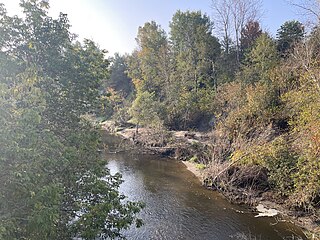
Deschambault-Grondines is a municipality located in the Portneuf Regional County Municipality (RCM), in the Capitale-Nationale region, Quebec, Canada.

Mékinac is a regional county municipality (RCM) of 5,607 km2 located in the administrative region of Mauricie, along the Saint-Maurice River, which also crosses the RCM from one end to the other, and the Matawin River, a tributary of the Saint-Maurice. Located in the province of Quebec, Canada.

Les Chenaux is a regional county municipality in central Quebec, Canada, in the Mauricie region. The seat is in Saint-Luc-de-Vincennes. It is located adjacent on the east of Trois-Rivières on the Saint Lawrence River. It has a land area of 872.04 square kilometres (336.70 sq mi) and a population of 17,865 inhabitants in the Canada 2011 Census. Its largest community is the parish of Notre-Dame-du-Mont-Carmel.

Route 354 is an east-west regional road in Quebec, Canada, starting from Route 159 north of Ste-Anne de la Pérade going to St-Raymond. It follows the Rivière Ste-Anne on the south shore most of the time. It is 55 km long, and overlaps Route 363 about 4 km in St-Casimir. Between St-Casimir and Ste-Anne-de-la-Pérade, it is named the "Rapide Nord", where it is the only part it is on the north shore of the river. It becomes rue Tessier Ouest in the village zone. This section was really bad until fall 2005, when it was newly paved on 12 km. Once it crosses the Rivière Ste-Anne, in the village of St-Casimir, it takes the name of rue (street) Notre-Dame.

Sainte-Anne River, Teyaiar River, rivière Sainte-Anne (French), flows from north to south on the north shore in the estuary section of the St. Lawrence River, in Les Chenaux, Portneuf and La Jacques-Cartier RCM, Mauricie and National Capital regions, Quebec, Canada.

Sainte-Anne-de-la-Pérade is a municipality located on the north shore of the St. Lawrence River, in Les Chenaux RCM, Mauricie region, Quebec, Canada.

Sainte-Christine-d'Auvergne, formerly Sainte-Catherine, is located along the banks of the Sainte-Anne River, in the Capitale-Nationale region, Portneuf RCM, Quebec, Canada.

Trou du Diable is a cave situated in Portneuf Regional Natural Park, St-Casimir Municipality, Portneuf RCM, Capital Nationale, Quebec, Canada.

Sainte-Geneviève-de-Batiscan is a parish municipality in the Mauricie region of the province of Quebec in Canada. This municipality is part of the Les Chenaux Regional County Municipality in Batiscanie and in the administrative region of Mauricie. It is located along the Batiscan River.

Saint-Alban is a municipality located in Portneuf RCM, Capitale-Nationale region, Quebec, Canada.

Rivière-à-Pierre is a municipality of the Portneuf Regional County Municipality, in the administrative region of the Capitale-Nationale. This area of the Laurentian Mountains is part of the Batiscanie and has more than 200 lakes. The village of Rivière-à-Pierre was developed on each side of the river that bears its name. Rivière-à-Pierre is the second largest municipality in the Portneuf RCM in terms of area.

Batiscanie, a vernacular name, of a territory located in the Mauricie region, divided between the RCMs of Les Chenaux, Portneuf and Mékinac, in Quebec, Canada.

The Charest River originates from Charest Lake in the Montauban-les-Mines area, located in the eastern part of Notre-Dame-de-Montauban, within the Mekinac Regional County Municipality, in the administrative region of Mauricie in the province of Quebec, Canada. It flows southward, passing through several regions and receiving water from lakes such as Mine, Perron, Perreault, and End in its upper course.

Noire River, Rivière Noire is one of the main watercourses of the Sainte-Anne River watershed, it measures 62 km in length, its watershed has an area of 568 km².

Lake Montauban is located in the municipalities of Rivière-à-Pierre and Saint-Alban, Portneuf RCM, Capitale-Nationale, Quebec, Canada.

The Blanche River (St-Casimir) is a stream flowing in the municipalities of Saint-Ubalde, Saint-Thuribe, Saint-Alban and Saint-Casimir, in Portneuf RCM, Capitale-Nationale, Quebec, Canada.

The Niagarette River is a stream flowing in the municipalities of Saint-Ubalde, Saint-Thuribe and Saint-Casimir, in the Portneuf Regional County Municipality, in the administrative region of Capitale-Nationale, in Quebec, in Canada.

Portneuf Regional Natural ParkParc naturel régional de Portneuf (French), is located on the territory of Portneuf City and the municipalities of Saint-Ubalde, Saint-Alban, Saint-Casimir and Rivière-à-Pierre, Portneuf RCM, Capitale-Nationale, Quebec, Canada.

Long Lake, Lac Long (French), is entirely located in Saint-Alban (Municipality), Portneuf RCM, Capitale-Nationale, Quebec, Canada.

Lake Clair (Sainte-Christine-d'Auvergne), Lac Clair (French) is located in the municipalities of Saint-Alban and Sainte-Christine-d’Auvergne, Portneuf RCM, Capitale-Nationale, Quebec, Canada.























